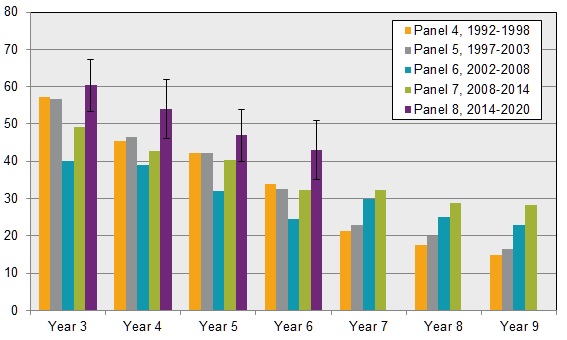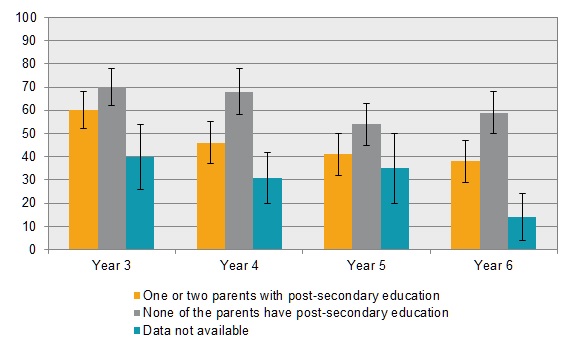Panel of students for longitudinal studies, school year 2016/17
More foreign born pupils participate in ”Swedish as second language”
Statistical news from Statistics Sweden 2017-12-12 9.30
The participation rate of foreign-born pupils in “Swedish as second language” classes in years 3-6 of compulsory education has increased. Among the foreign born pupils who were in grade 3 in the 2013/14 school year, roughly 45 per cent participated in ”Swedish as second language” classes in year 6 in the spring of 2017. In the spring of 2005, the percentage among foreign-born pupils was 25 per cent.
In the "Panel of students for longitudinal studies" survey, a sample of 10 per cent of the pupils in year 3 of compulsory school is followed through years 3-9. In the spring of 2017, panel 8 was surveyed and the majority of the pupils were in year 6.
About 10 per cent of the pupils in year 3 in school year 2013/14 were foreign born. The rate of foreign-born pupils participating in “Swedish as second language” have decreased from roughly 60 per cent in year 3 to 45 per cent in year 6. A similar pattern can be found in earlier panels where the participation rate gradually decreases between year 3 and 6. Among the native-born pupils, the participation rate is around 5 per cent in year 6 and there is no sign of a decrease between years 3 to 6.

Among the foreign born pupils who participated in ”Swedish as second language” classes in the spring of 2017 and for whom we have complete information on years 3-6 there were roughly 60 per cent that participated in all years. About 5 per cent participated for the first time in year 6.
It was more common for foreign-born pupils where neither of the parents have post-secondary education to participate in “Swedish as second language” classes compared to pupils with at least one parent with post-secondary education. Among the pupils where neither of the parents have post-secondary education it was roughly 60 per cent that participated in “Swedish as second language” classes in the spring of 2017. Among pupils with at least one parent having attained post-secondary education, the corresponding rate is 40 per cent. The decrease of the percentage of pupils participating in “Swedish as second language” between the year 3 and 6 has been greater among pupils with at least one parent with post-secondary education than among pupils whose parents have a lower level of education. Thus, the difference in the percentages participating in “Swedish as second language” concerning parental education was not as clear in year 3 as it was in year 6.
Almost half of the foreign born pupils participated in native language teaching
In year 6, roughly 45 per cent of the foreign-born pupils participated in native language teaching. About 65 per cent of the foreign-born pupils who attended “Swedish as second language” classes also attended native language classes. The participation rate was about the same for boys and girls in both “Swedish as second language” and in native language teaching.
Percentage of pupils in remedial tuition decreasing in year 3-6
Between year 3 and 6 the percentage of pupils with remedial tuition have decreased. Since the early 1990s, the percentage in years 3, 4, 5 and 6 has been halved. In year 7-9, the percentage of pupils taking part in remedial tuition has remained more stable.

Almost 10 per cent of the pupils in municipal schools took part in remedial tuition in year 6 in 2017. In independent schools the corresponding proportion was about 5 per cent. This suggests that the proportion of participants in independent schools has decreased compared to last school year when the rate was about 10 per cent.

About 25 per cent of the boys for whom we have complete information on years 3-6 had remedial tuition at least one of those years compared to 20 per cent of the girls.This is consistent with the results in the Swedish National Agency for Education’s report on remedial tuition during school year 2016/17. The report suggests that all kinds of remedial tuition are more frequent among boys compared to girls.
The percentage of pupils who took part in remedial tuition differs, based on the parent’s level of education. In the spring of 2017, about 5 per cent of the pupils with at least one parent having post-secondary education participated in remedial tuition. Among those, where neither of the parents have post-secondary education the rate was roughly 10 per cent.
Roughly, 30 per cent of the pupils for whom we have complete information on years 3-6 and who took part in remedial tuition in year 6 participated for the first time in year 6. The remaining 70 per cent have had remedial education in a previous year.
About 55 per cent of the pupils who participated in remedial tuition had an action plan. Action plans are more common among pupils whose parents have no post-secondary education.
Definitions and explanations
The "Pupil panels for longitudinal studies" survey has been conducted since the early 1980s. A sample of 10 per cent of the pupils in year 3 of compulsory school is followed through year 3-9. Most of the pupils were born 10 years before the first follow-up occasion. Comparable surveys have been conducted for pupils who were born in mainly 1967, 1972, 1977, 1982, 1987, 1992, 1998 and 2004. Follow-up surveys are conducted each spring and data are collected from the schools the pupils attend at the time of the survey.
In the spring of 2017, panel 8 was surveyed. Panel 8 consists of a sample of 9 800 pupils who attended year 3 in the 2013/2014 school year. Since this is a sample survey, the estimations are marred by a sampling error. In the spring of 2017, the response rate was 67 per cent.
Since the samples are drawn in year 3, pupils who moved to Sweden after year 3 are not included; nor are pupils included who sometime during year 3-9 were enrolled in the compulsory school for pupils with learning disabilities.
Next publishing will be
2018-12-11 at 09:30.
Statistical Database
More information is available in the Statistical Database
Feel free to use the facts from this statistical news but remember to state Source: Statistics Sweden.

